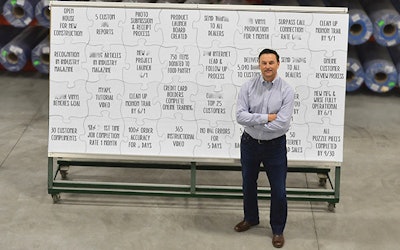
Setting goals one of the most fundamental parts of running a successful business — and it's an especially important tool for managing staff members. Beyond the obvious benefit of giving everyone in your company something to strive for, strategic goal setting is one the best ways to communicate your priorities. But there are also challenges in laying out goals for a whole organization. For example, there's the dilemma that has divided management gurus for ages: Should goals be so significant that they are unlikely to be reached, ensuring that everyone will always have something to strive for? Or should the goals be smaller and highly attainable, thus giving everyone a chance to notch a win?
According to Michael Shebek, owner and president of Automatic Pool Covers, managers don't need to choose between big and small goals. Instead, they can use both.
At Automatic Pool Covers (Westfield, Ind.), goals are implemented in a structure called "The Puzzle." In this system, employees are given big-picture goals as well as a series of small, task-driven goals that push the team closer to reaching the larger goal.
The most recent iteration of "The Puzzle" featured four overarching goals: increase sales, be more efficient, enhance employee enjoyment and improve communication, both internally and externally. All are admirable goals, but broad. So Shebek and his team created eight subgoals under each main goal, each of which is more readily attainable and, crucially, measurable.
For example, even with hard numbers available, increasing sales can still be a fairly nebulous goal. It's also one that can be impacted by market forces and other external factors, making the closing tally on a spreadsheet a potentially imperfect measure.
RELATED: Set Sales Goals Today and See Results Tomorrow
So Shebek and his team came up with an analogous goal that was easy to measure and entirely within their control. Starting with the premise that a major part of sales begins with simply getting time with potential customers, the company determined to deliver 1,000 doughnuts to sales targets over a set period of time.
"How do you increase sales?" Shebek asks. "Well, you have to start at the ground level, and that's just getting yourself in front of people. If that's dropping off 1,000 doughnuts, then that's the goal. If we accomplish dropping off 1,000 doughnuts, then mission accomplished. We celebrate that."
Different members of the organization take responsibility for fulfilling and tracking specific subgoals, and there are monthly meetings that include a check-in on progress. (As a side benefit, the practice of delivering status updates to the group provides an opportunity for employees to hone their public speaking and presentation skills.)
 After accomplishing a goal, employees were rewarded with a lunch of their choice.
After accomplishing a goal, employees were rewarded with a lunch of their choice.
Most small goals are not impactful enough to truly shift the fortunes of a company, especially one with large revenue streams and a significant population on the payroll. That's precisely why some of the larger, more aspirational goals need to be in place, too.
The smaller goals, however, set the tone in a powerful way. By giving staff members a set of tasks that can be achieved, and then also providing the platform to stand in front of the whole organization and tout their accomplishments, a company can start to establish a culture of achievement. The good work perpetuates itself.
"The more success you have and the more people feel proud about what they've done, the more you enhance employee enjoyment," Shebek notes. "It's valuable to be recognized in front of 100 people for exceptional work, it doesn't matter what it is — keep the shop floor clean for five days, for example. The guy who mops the floor or sweeps the floor at the end of the day is recognized in front of everybody."
RELATED: Take Your Business Performance to the Next Level
Your employees have a wide variety of skills. As part of your organization, those skills should be applied to the greater good. Acknowledging those contributions drive further contributions, and smartly set goals can be the best means to give the celebration added weight. It's not just a pat on the back — it's hard-earned appreciation.
Shebek concedes that actually creating the goals is the most difficult part of the equation. The process at Automatic Pool Covers starts with the large goals and works backyards by posing the question, "Well, how do we accomplish that?"
Subgoals also need to be developed thoughtfully with special attention to the ease with which they can be communicated. If a subgoal seems detached from its larger goal or can't be expressed plainly, there's a real risk that employees won't get behind it. Once a subgoal is perceived as busywork, it's not going to motivate anyone. And in an interconnected model, just one faulty component can compromise the whole structure.
But, like the goals themselves, if setting the targets were easy, it probably wouldn't be worth doing. In order to keep an business moving forward, the engines of productivity need a little fuel. Giving members of the organization goals — big and small — provides exactly that.
Daniel Seeger is a trade magazine editor based in Madison, Wis. His areas of expertise include distribution, healthcare and the pool and spa industry. He holds a master's degree in corporate communication and technology from Rollins College.











































